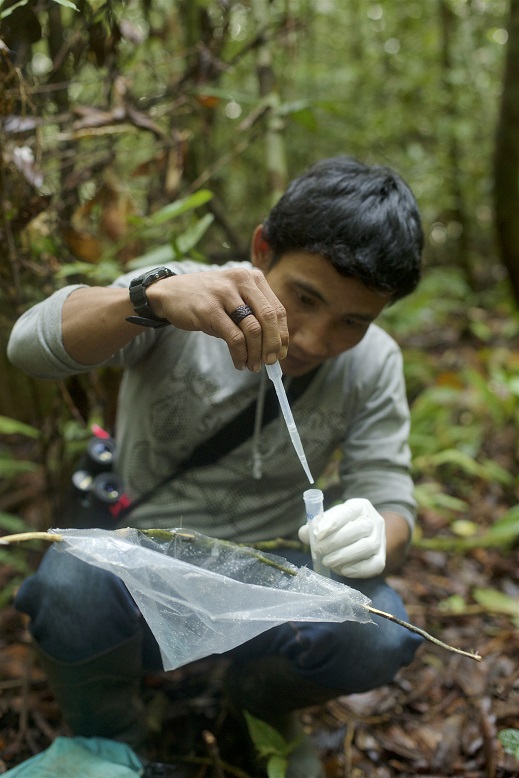
Project Overview
We conducted one of
the first studies of ovarian function in wild non-human primates, and developed
now-widespread techniques using non-invasive endocrine markers. We developed
methods to collect urine and dry it on filter paper for later laboratory analysis
to extract ovarian hormone metabolites to characterize female reproductive
state. Our research project revealed close correspondence between female
ovarian function, energy intake, and expenditure driven by physiological and
behavioral responses to changes in fruit availability. We confirmed that
orangutan reproduction is strongly tied to environmental variability and
orangutans show faster reproduction in energetically-rich environments.
In Gunung Paluang
National Park, orangutans conceive when fruit is abundant and they have
relatively high reproductive hormone levels. During fruit-poor periods, hormone
levels are likely sufficiently suppressed to prevent conception and ovarian
cycling. Furthermore, reproductive rates, and by extension population persistence
and species survival, are constrained by females’ ability to obtain sufficient
resources to sustain reproductive costs. One of our current research questions
is to understand if environmental degradation leads to lower energy intake and
its impact on orangutan ovarian function and reproduction.
Related Publications
van Noordwijk MA, SS Utami Atmoko, CD Knott, N Kuze, HC Morrogh-Bernard, F Oram, C Schuppli, CP van Schaik, and EP Willems. (2018). The Slow Ape: High Infant Survival and Long Inter-Birth Intervals in Orangutans. Journal of Human Evolution. 125: 38-49. doi.org/10.1016/j.jhevol.2018.09.004
Emery Thompson M, A Zhou, and CD Knott. (2012). Low Testosterone Correlates with Delayed Development in Male Orangutans. PLoS ONE. 7:(10) 1-7.
Knott CD, ME Thompson and SA Wich. (2009). The Ecology of Reproduction in Wild Orangutans. In: SA Wich, SS Utami, T Mitra Setia and C van Schaik (Eds.), Orangutans Compared: Ecology, Evolution, Behaviour and Conservation. Oxford University Press: Oxford, p. 171–188.
Anderson H, M Emery Thompson, CD Knott and L Perkins. (2008). Fertility and Mortality Patterns in Captive Bornean and Sumatran Orangutans: Is There a Species Difference in Life History? Journal of Human Evolution. 54: 34–42.
Knott CD. (2005). Radioimmunoassay of Estrone Conjugates from Urine Dried on Filter Paper. American Journal of Primatology. 67:(1), 121–135.
Knott CD. (2005). Energetic Responses to Food Availability in the Great Apes: Implications for Hominin Evolution. In: DK Brockman and CP van Schaik (Eds.), Primate Seasonality: Implications for Human Evolution. Cambridge University Press: Cambridge, p. 351–378.
Knott CD. (2001). Female Reproductive Ecology of the Apes: Implications for Human Evolution. in Reproductive Ecology and Human Evolution. P. Ellison. Aldine de Gruyter: New York, p. 429–463.
Knott CD. (1998). Changes in Orangutan Diet, Caloric Intake and Ketones in Response to Fluctuating Fruit Availability. International Journal of Primatology. 19:(6) 1061–1079.
Knott CD.
(1996). Field Collection and Preservation of Urine in Orangutans and
Chimpanzees. Tropical Biodiversity. 4(1): 95–102.
Differences in the optimal reproductive strategies of males and females create sexual conflict over when, how frequently and with whom matings will occur. Orangutans are a highly dimorphic species, females face particular challenges to develop strategies that increase the probability of obtaining a high-quality sire while minimizing the potential costs of infanticide and other forms of sexual coercion.
Orangutan males are unique as they occur in two sexually mature morphs: flanged and unflanged. Prime flanged males are very large (approx. 86 kg), possess fleshy, protruding cheek flanges or pads, produce long call vocalizations and are dominant to unflanged males. Unflanged males have not developed these secondary sexual characteristics, yet are sexually mature. Our research investigates reproductive strategies of females, flanged males, and unflanged males and how energetics mediate these behaviors.
